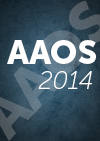
AAOS: Wear of oxinium/cobalt-chrome on standard/cross-linked polyethylene

AAOS: Wear of oxinium/cobalt-chrome on standard/cross-linked polyethylene
Randomized Controlled Trial Comparing Wear of Oxinium and Cobalt-Chrome on Standard and Cross-Linked Polyethylene
CONFERENCE ACE REPORTS
This ACE Report is a summary of a conference presentation or abstract. The information provided has limited the ability to provide an accurate assessment of the risk of bias or the overall quality. Please interpret the results with caution as trials may be in progress and select results may have been presented.
Synopsis
80 patients (91 hips) undergoing total hip arthroplasty were randomly allocated to one of four bearing surfaces: cobalt-chrome (CoCr) & standard polyethylene, CoCr & cross-linked polyethylene (XLPE), oxinium & standard polyethylene, or oxinium & XLPE, to compare long-term polyethylene wear rate between groups. Results indicated that the wear rate was significantly reduced with cross-linked polyeth...
To view the full content, login to your account,
or start your 30-day FREE Trial today.
FREE TRIAL
LOGIN
Forgot Password?
Explore some of our unlocked ACE Reports below!

Learn about our AI Driven
High Impact Search Feature
Our AI driven High Impact metric calculates the impact an article will have by considering both the publishing journal and the content of the article itself. Built using the latest advances in natural language processing, OE High Impact predicts an article’s future number of citations better than impact factor alone.
Continue



 LOGIN
LOGIN

Join the Conversation
Please Login or Join to leave comments.